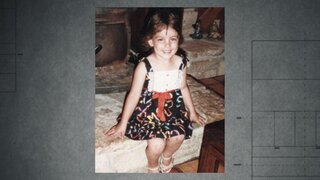Create a free profile to get unlimited access to exclusive videos, breaking news, sweepstakes, and more!
Young Texas Mom Found Dead In Office Building Bathroom — Who Was Her Killer?
"My whole world changed," Laurie Stout's sister said of the moment she learned her big sister was dead. "I no longer had my confidante and no longer had my best friend. It was horrible."
The road to justice for Laurie Stout’s family was anything but easy.
The devoted 22-year-old Texas mom was brutally murdered on Sept. 20, 1983 inside a bathroom stall at an Austin office building where she had worked cleaning, but it would take decades to bring her surprising killer to justice.
Stout was discovered around 8 a.m. by an employee of the office building inside a stall of the upstairs men’s restroom.
“She was undressed, there was insulated electric wire that had small loops tied on the ends of them. Detectives believed that the electrical wire was used to strangle her and be the cause of her death,” Amy Casner, assistant district attorney with Travis County told “An Unexpected Killer," airing Fridays at 8/7c on Oxygen. “It appeared because she had no defensive wounds at all that the killer came up from behind and surprised her.”
The killer had also shoved wet toilet paper inside her nose and mouth, presumably after he strangled her to ensure that she would not survive. There were also signs that Laurie had been dragged into the bathroom stall and sexually assaulted.
“Everything in the crime scene suggested that this was a violent attack,” said JJ Schmidt, a detective with the Austin Police Department.
Her death shocked her family, who described Laurie as a caring and compassionate person.
“I was in shock. I couldn’t believe it. My whole world changed. I no longer had my confidante and no longer had my best friend. It was horrible,” sister Beverly Casaubon said.
Laurie, the oldest of three children, had grown up in Arlington, Virginia before moving with her mom and siblings to Austin. It was there she met Gary Stout and quickly fell in love. The pair married in 1978.
Three years later, they were expecting a baby.
“She was over the moon. Very, very happy. I mean, that’s what she wanted, she wanted to be married and start having a family,” Casaubon said.
But who could have wanted the young mom dead?
Investigators were left with some clues found at the scene, including a fingerprint on the men’s stall of the bathroom that matched a print found on the door of the second-floor fire escape. Detectives also found a spool of insulated electrical wire inside a dumpster near the building, along with pieces of cut wire similar to those used to kill Laurie.
Casner said authorities also knew that because Laurie was killed overnight, the murderer either had to have a key to the building or have access in some way.
Witnesses reported seeing Laurie in the building around 12:30 a.m. as they locked up the building and left. She wasn’t discovered by the building tenant until 8 a.m., giving authorities a large possible window for when Laurie may have been killed.
One of the first possibilities investigators considered was Laurie’s husband, Gary, who had rushed into the building the morning she was discovered after he realized she had never come home.
Like his wife, Gary — a military veteran — had worked in the office building but told officers at the time of the murder he had been at home with the couple’s young daughter.
Investigators learned that before Stout’s death the couple had hit a rough patch in their relationship and Laurie sought refuge at her sister’s house after a fight shortly before her death. Gary also confessed to having an affair while he was overseas with the military and told authorities he had considered leaving his wife.
He claimed he decided to stay in the marriage, but told authorities the last time he saw Laurie they had once again been fighting before she left for work.
“Laurie’s family felt very strongly that he was the killer,” Casner said.
But, Gary was cooperative with detectives and provided samples of his blood and fingerprints.
Although it was years before the introduction of DNA analysis, authorities did obtain a sample from Laurie’s sexual assault and used blood type antigens to narrow the field of potential suspects.The samples taken from Gary were inconclusive; however, he did pass a polygraph and without any concrete evidence to tie him to the crime, authorities let him go.
As they searched for possible suspects, investigators focused on employees who had access to the building. Authorities also learned that on the night Laurie was killed, the University of Texas’ satellite location had also been holding registration for students inside the building.
“What’s difficult particularly about a public space like this is so many people have access,” Schmidt said.
Detectives gathered the names of the male students who had come into the building that night and collected their fingerprints. The fingerprints of one of the men, an 18-year-old named Robert Van Wisse, matched the fingerprints recovered on the bathroom stall door and fire escape door.
The young college student admitted to using the bathroom and leaving through the fire escape door after 12:15 a.m. after signing up for classes, but insisted he had not killed Laurie. Two employees of the building also confirmed seeing him leave the building.
Van Wisse, the son of well-respected surgeons in the area, willingly provided a blood sample, which authorities were told was not a match to the bodily fluids left during the sexual assault.
Detectives also looked into the possibility that the crime might have been carried out by a convicted killer who had been in Austin the night of the murder and had also attempted to strangle another victim who survived her attack. However, once again, his fingerprints and blood sample ruled him out as a possible suspect.
For years the case went cold, until 1992 when a new set of investigators took a new look at the case. By then, authorities were able to officially rule Gary out as the killer through DNA — but they also discovered something else startling about the initial investigation.
Although detectives had been told the blood sample ruled Van Wisse out as the killer, the documentation contained an error, and he was actually unable to be ruled out at the time based on his blood sample.
“This is a big turning point in the investigation,” Casner said.
A new look at the fingerprint evidence also revealed that Van Wisse’s fingerprint was not only found on the door to the fire escape, but it was also found on the outside handle, suggesting that the 18-year-old may have returned through that door at some point.
Investigators wanted to speak with Van Wisse again, but they learned he was living out of the country and his family was uncooperative in helping them find the former college student.
In his absence, authorities were able to secretly collect DNA evidence from his brothers, which confirmed their suspicions. He was likely the person who had left behind the bodily fluid in the sexual assault.
Investigators had their killer but it would take decades to apprehend him.
Van Wisse ultimately surrendered to authorities after he was placed on the FBI’s Top 10 “Most Wanted” list in late 2016, according to KTBC.
He plead guilty in 2017 in exchange for a sentence of 30 years behind bars.
“I looked him right in the eye and told him what he had taken from our family and what it had done,” Casaubon said of addressing Van Wisse during the sentencing. “I just told him I hope he rots in hell and gets to feel some of that terror that my sister felt that night.”
For more on this case and others like it, watch "An Unexpected Killer,” airing Fridays at 8/7c on Oxygen or stream episodes here.




































